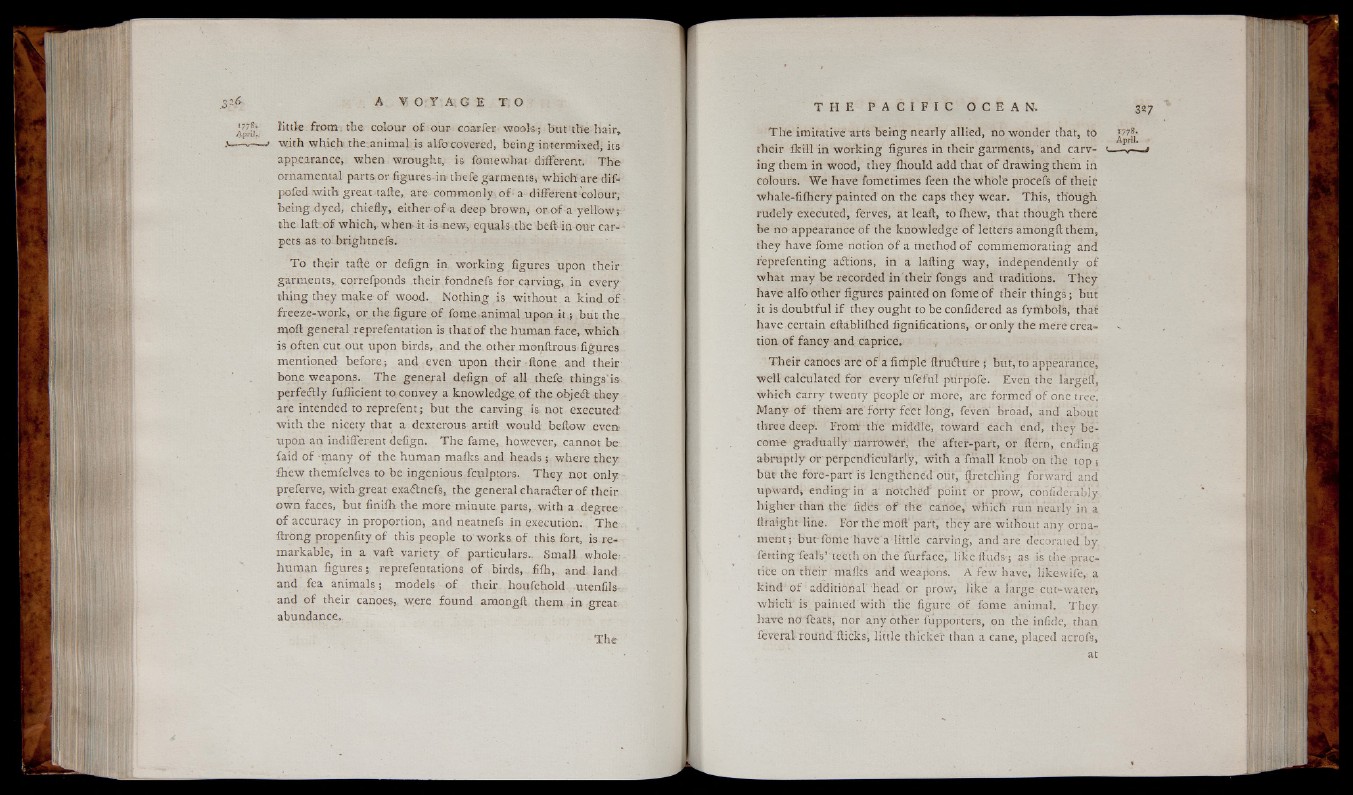
J77*- little from , the colour o f our coarfer wools; but the hair,
— — / w ith w hich the.animal is alfocovered, be in g intermixed, its
appearance, when wrought, is fomewbat different. T he
ornamental parts or figures in tbefe garments) w hich are dif-
pofed w ith great tafte, a re commonly of- a different colour;
b e in g dyed, chiefly, either of-a deep brown,- or o f a y e llow ;
the laft: o f which, when- it is new, equals,the beft in our carpets
as to brigbtnefs.
T o their tafle or defign in w o rk in g figures upon their
garments, cqrrefponds their fondnefs for carving, in every
thin g they make o f wood,. Nothing is without a kind o f
fre eze-work , or the figure o f fome.animal upon it.; but the
moll general reprefentation is that"of the human face, w h ich
is often cut out upon birds, , and the other monftrous figures
mentioned be fo re; and even upon their Hone and their
bone weapons. T he general defigp o f all thefe, th in g s 'is
perfedlly fufficient to. convey a knowledge o f the objedt th e y
are intended to reprefent; b u t the carving is not executed
w ith the nicety that a dexterous anift would bellow even,
upon an indifferent defign. T h e fame, however, cannot be
faid o f many o f the human malks and heads ; where they
ih ew themfelves to be ingenious fculptors. T h e y not only
preferve, with great exa&nefs, the general character o f their
own faces, but finilh the more minute p a r ts,. with a degree-
o f accuracy in proportion, and neatnefs in execution. T he
itrong propenfity o f this people to'works o f this fort, is remarkable,
in a vail variety o f particulars. Small whole-
human fig u r e s ; representations o f birds, fifh,. and land
and fea anima ls; models o f their houfehold utenfils
and o f their canoes, were found amongll them in great
abundance.
T h e imitative arts b e in g nearly allied, no wonder that, to
their fkill in w o rk in g figures in their garments, and carv- v— „—
in g them in wood, they ihould add that o f drawing them in
colours. We have fometimes feen the whole procefs o f their
whale-filhery painted on the caps they wear. This, though
ru dely executed, ferves, at lealt, to ihew, that though there
be no appearance o f the kn owledge o f letters amongftthem,
they have fome notion o f a method o f commemorating and
reprefenting adtions, in a lalting way, independently o f
what ma y be recorded in their fongs and traditions. T h e y
have alfo other figures painted on fome o f their th in g s ; but
it is doubtful i f they ought to be confidered as fymbols, that
have certain eftablifhed fignifications, or only the mere creation
o f fan cy and caprice.
T h e ir canoes are o f a fimple ftrudture ; but, to appearance,
w e ll calculated for every ufefiul purpofe. Even the largeff,
which carry twenty people or more, are formed o f one tree'
Many o f them are forty feet long, feveri broad, and about
three deep. From the middle', toward each end, they be come
g rad u a lly narrower; the after-part, or Hern, ending
abruptly o r perpendicularly, witfi a fmall kn o t' on the top ;
bur the fore-part is lengthened out, flfe tchin g forward and
upward; endin g-in a notched1 point dr prow, cdniiderably
h ig h e r than the fideS o f the- canoe, which run n ea rly 'in a
flraight line. For the moil'part, they are without any ornam
en t; but forrie liave a little carving, and are decorated by
fetting; feal's’ teeth on the furface,.'lilie liuds-j as is the practice
on their maflis and weapons. A few have, likewife,- a
kind o f additional head or prow, lik e a large cut-water,
w hich is painted with tlie figure o f fome animal. T he y
have no ftats, nor any other liipporters, on tlie infide, than
feveral round flicks, little thicker than a cane, placed acrofs,
at